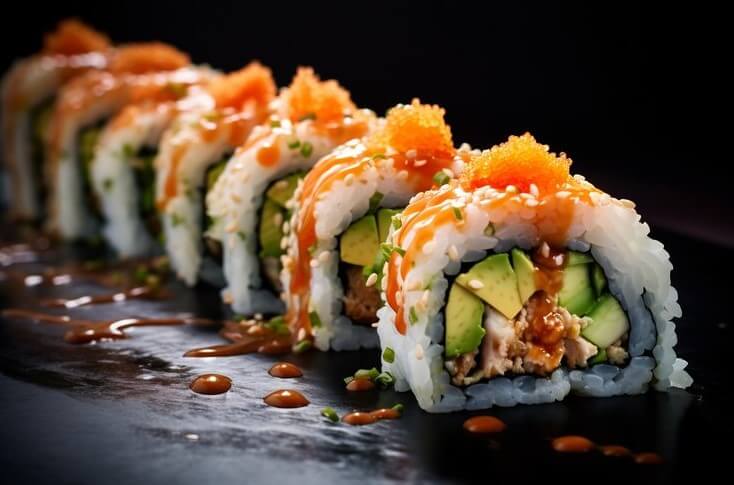Introduction to Salmon Rolls
Salmon rolls, a beloved delicacy in Japanese cuisine, have captivated food enthusiasts around the globe. Their origin traces back to ancient Japan, where they were a cherished part of the sushi tradition. Over time, these rolls have evolved, embracing both traditional and innovative culinary approaches.
The allure of salmon rolls lies in their versatility and the delicate balance of flavors. They come in various forms, each offering a unique taste experience:
- Traditional Salmon Rolls: These are the epitome of simplicity, featuring fresh, sashimi-grade salmon wrapped in sushi rice and nori. They are celebrated for showcasing the salmon’s natural flavor.
- Spicy Salmon Rolls: A favorite for those who enjoy a bit of heat, these rolls are spiced up with sriracha or spicy mayo, often accompanied by avocado or cucumber.
- Smoked Salmon Rolls: A Western twist to the classic roll, incorporating smoked salmon for a distinct, rich flavor.
This rich variety not only highlights the versatility of salmon as an ingredient but also showcases the creative adaptability of sushi itself, making salmon rolls a globally cherished dish.
Types of Salmon Rolls
Traditional Salmon Roll
The Traditional Salmon Roll is a classic representation of sushi’s elegance and simplicity. The key ingredients include:
- Sashimi-grade salmon: Fresh and of high quality, often thinly sliced.
- Sushi rice: Short-grain rice seasoned with a mix of rice vinegar, sugar, and salt.
- Nori sheets: Dried seaweed used to wrap the ingredients.
Preparation:
- Lay a sheet of nori on a bamboo sushi mat.
- Spread a thin layer of sushi rice over the nori, leaving a small margin at the top.
- Place slices of salmon along the rice.
- Gently roll the sushi using the mat, applying even pressure.
- Slice the roll into bite-sized pieces with a sharp, wet knife.
Regional Variations:
- In Japan, traditional rolls are often simpler, focusing on the quality of the salmon.
- Western variations might include additional ingredients like avocado or cream cheese.
Spicy Salmon Roll
The Spicy Salmon Roll adds a fiery twist to the traditional roll. Ingredients include:
- Sashimi-grade salmon, diced or sliced.
- Sriracha sauce or spicy mayo for heat.
- Sushi rice and nori sheets.
- Optional: avocado, cucumber, or scallions for added texture and flavor.
Preparation:
- Mix diced salmon with sriracha or spicy mayo in a bowl.
- Spread sushi rice on a nori sheet on a bamboo mat.
- Add the spicy salmon mixture along with any additional fillings.
- Roll the sushi tightly, then slice into pieces.
The spicy flavor profile is a delightful contrast to the cool, creamy texture of the salmon, making it a popular choice in many sushi restaurants. Learn more about making your own spicy salmon roll with this detailed recipe.
Smoked Salmon Rolls
Smoked Salmon Rolls offer a unique take on sushi, featuring:
- Smoked salmon, offering a rich, deep flavor.
- Cream cheese or avocado for creaminess.
- Cucumber for crunch.
- Sushi rice and nori sheets.
Preparation:
- Place nori on a bamboo mat and cover with sushi rice.
- Add a layer of cream cheese or avocado.
- Place strips of smoked salmon and cucumber on top.
- Roll the sushi, slice, and serve.
Serving Suggestions:
- Serve with soy sauce, wasabi, and pickled ginger.
- Pair with a light salad or miso soup for a complete meal.
These rolls are a fantastic option for those who prefer cooked over raw fish, offering a delightful blend of smoky and creamy flavors. The smoky flavor of the salmon pairs wonderfully with the creaminess of the cheese. For a unique twist on this recipe, visit Simply Home Cooked.
Nutritional Value of Salmon Rolls
Health Benefits of Salmon
Salmon, a key ingredient in salmon rolls, is renowned for its exceptional nutritional value. It is a powerhouse of essential nutrients that contribute to overall health and well-being.
Nutritional Content:
- Omega-3 Fatty Acids: Salmon is rich in omega-3 fatty acids, which are crucial for heart health, reducing inflammation, and supporting brain function.
- Protein: It is an excellent source of high-quality protein, essential for muscle maintenance and overall body health.
- Vitamins and Minerals: Salmon is packed with vitamins D and B12, selenium, and potassium, among others, contributing to bone health, immune system support, and nerve function.
Benefits of Including Salmon in Your Diet:
- Heart Health: Regular consumption of salmon can help lower blood pressure and reduce the risk of heart disease.
- Brain Function: Omega-3 fatty acids aid in cognitive function and may reduce the risk of age-related mental decline.
- Joint Health: The anti-inflammatory properties of omega-3s can alleviate symptoms of arthritis.
- Skin Health: The nutrients in salmon promote healthy skin by protecting against UV rays and aiding in skin repair.
Incorporating salmon into your diet, such as through salmon rolls, offers a delicious way to enjoy these health benefits while indulging in a culinary delight.
Cooking Techniques for Salmon Rolls
Preparing the Perfect Salmon Roll
Crafting the perfect salmon roll is an art that combines skill with the selection of quality ingredients. Here are key considerations and tips to ensure your rolls are both delicious and visually appealing.
Selecting the Right Ingredients:
- Salmon: Choose fresh, sashimi-grade salmon for its flavor and texture. It should have a bright color and a clean smell.
- Rice: Use short-grain sushi rice for its sticky consistency. Cook it to the right texture and season with sushi vinegar for authentic flavor.
- Nori: Select high-quality nori sheets that are crisp and without any tears.
Tips for Rolling and Cutting:
- Rice Preparation: Accordingly, keep your hands wet when handling sushi rice to prevent sticking.
- Layering: Spread a thin, even layer of rice on the nori, leaving a small margin at the top for sealing the roll.
- Filling Placement: Place the salmon and any additional ingredients in a line along the bottom third of the rice.
- Rolling Technique: Use a bamboo mat to roll the sushi. Start from the bottom, gently lifting the mat and rolling it forward to encase the fillings.
- Applying Pressure: Apply even pressure along the roll with the mat to compact the ingredients and ensure the roll is tight and holds its shape.
- Cutting: Use a sharp, wet knife to cut the roll into even pieces. Clean the knife after each cut to maintain clean edges.
- Presentation: Arrange the pieces neatly on a plate, garnished with pickled ginger and wasabi.
Mastering these techniques will not only enhance the flavor of your salmon rolls but also their presentation, making them a joy to both make and eat.
Serving and Pairing of Salmon Rolls
Serving Suggestions
Salmon rolls, with their delicate flavors and textures, can be elevated with the right accompaniments and drink pairings. Here are some suggestions to enhance your sushi experience:
Accompaniments and Garnishes:
- Soy Sauce: A classic dip that adds a salty umami flavor. Opt for low-sodium soy sauce to control salt intake.
- Wasabi: This pungent green paste adds a fiery kick. Use sparingly to complement, not overpower, the salmon’s flavor.
- Pickled Ginger: Served as a palate cleanser between bites, it’s refreshing and aids in digestion.
- Sesame Seeds: Sprinkle toasted sesame seeds for a nutty flavor and a decorative touch.
- Scallions or Chives: These add a mild oniony zest and a pop of color.
Drink Pairings:
- Green Tea: A traditional choice, green tea’s bitterness balances the richness of the salmon.
- Sake: This Japanese rice wine pairs beautifully with sushi, enhancing the flavors.
- Light White Wines: Choose a crisp and dry white wine, like Sauvignon Blanc or Pinot Grigio, for a harmonious pairing.
- Sparkling Water: For a non-alcoholic option, sparkling water with a slice of lemon complements the sushi without overwhelming its taste.
These serving and pairing options not only add to the gastronomic delight of salmon rolls but also turn the meal into a more holistic and enjoyable experience.
FAQs
- What is the best salmon for sushi rolls?
- Sashimi-grade salmon is recommended for its freshness and quality.
- Can I use cooked salmon instead of raw in salmon rolls?
- Yes, cooked salmon can be used, especially if you’re hesitant about raw fish. Smoked salmon is a popular alternative, offering a different but equally delicious flavor.
- How do I prevent sushi rice from sticking to my hands while making rolls?
- Keep a bowl of water mixed with a bit of rice vinegar nearby. Dipping your hands in this solution will prevent the rice from sticking.
Conclusion
In conclusion, salmon rolls blend taste, tradition, and nutrition beautifully. From the Traditional Salmon Roll to the Spicy Salmon Roll, and the unique Smoked Salmon Rolls, there’s a variety for every palate. Additionally, rich in omega-3s and nutrients, they’re not only delicious but also healthy. Furthermore, preparing these rolls is a rewarding experience. So, why not embark on this culinary adventure and try making your own salmon rolls? The journey is as exciting as the destination!! For more inspiration on salmon-based dishes, check out this introduction to Salmon Sushi Bake.


